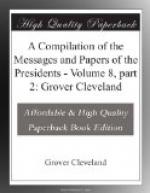He then became the law partner of Isaac V. Vanderpool,
and in 1869 became a member of the firm of Lanning,
Cleveland & Folsom. He continued a successful
practice till 1870, when he was elected sheriff of
Erie County. At the expiration of his three years’
term he formed a law partnership with his personal
friend and political antagonist, Lyman K. Bass, the
firm being Bass, Cleveland & Bissell, and, after the
forced retirement, from failing health, of Mr. Bass,
Cleveland & Bissell. In 1881 he was nominated
the Democratic candidate for mayor of Buffalo, and
was elected by a majority of 3,530, the largest ever
given to a candidate in that city. In the same
election the Republican State ticket was carried in
Buffalo by an average majority of over 1,600.
He entered upon the office January 1, 1882, and soon
became known as the “Veto Mayor,” using
that prerogative fearlessly in checking unwise, illegal,
and extravagant expenditures. By his vetoes he
saved the city nearly $1,000,000 in the first half
year of his administration. He opposed giving
$500 of the taxpayers’ money to the Firemen’s
Benevolent Society on the ground that such appropriation
was not permissible under the terms of the State constitution
and the charter of the city. He vetoed a resolution
diverting $500 from the Fourth of July appropriations
to the observance of Decoration Day for the same reason,
and immediately subscribed one-tenth of the sum wanted
for the purpose. His administration of the office
won tributes to his integrity and ability from the
press and the people irrespective of party. On
the second day of the Democratic State convention
at Syracuse, September 22, 1882, on the third ballot,
was nominated for governor in opposition to the Republican
candidate, Charles J. Folger, then Secretary of the
United States Treasury. He had the united support
of his own party, while the Republicans were not united
on his opponent, and at the election in November he
received a plurality over Mr. Folger of 192,854.
His State administration was only an expansion of
the fundamental principles that controlled his official
action while mayor of Buffalo. In a letter written
to his brother on the day of his election he announced
a policy he intended to adopt, and afterwards carried
out, “that is, to make the matter a business
engagement between the people of the State and myself,
in which the obligation on my side is to perform the
duties assigned me with an eye single to the interest
of my employers.” The Democratic national
convention met at Chicago July 8, 1884. On July
11 he was nominated as their candidate for President.
The Republicans made James G. Blaine their candidate,
while Benjamin F. Butler, of Massachusetts, was the
Labor and Greenback candidate, and John P. St. John,
of Kansas, was the Prohibition candidate. At
the election, November 4, Mr. Cleveland received 219
and Mr. Blaine 182 electoral votes. He was unanimously
renominated for the Presidency by the national Democratic




